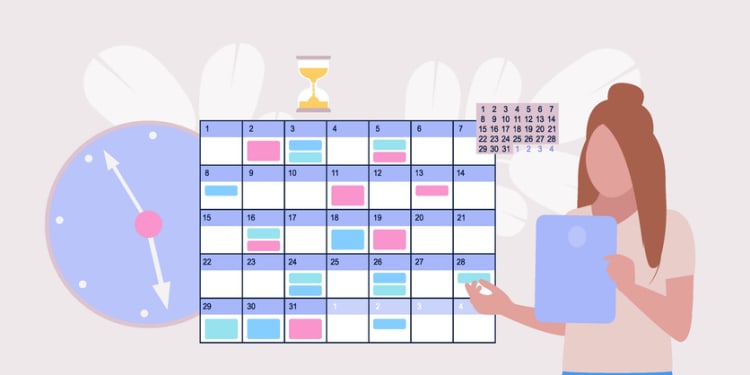Constantly chasing content deadlines? A content calendar can be your game-changer. This guide unpacks how an organized approach to content not only saves time but keeps your audience hooked with consistent, quality posts. Expect to discover the creation, benefits, and optimization of a content calendar, setting you up for a smoother marketing journey.
Key takeaways
- A content calendar is essential for streamlining marketing processes, improving organization and efficiency, and ensuring consistent, high-quality social media posts aligned with overall marketing goals.
- A well-crafted content calendar requires thoughtful platform selection, a diverse content mix, and strategic scheduling to maximize engagement and relevance to the target audience.
- Content calendars are dynamic tools that benefit from regular analysis and optimization, leveraging key metrics and audience feedback to refine content strategy and improve post performance.
The importance of a content calendar

A social media content calendar is akin to a navigational tool that steers your marketing initiatives toward impactful outcomes. This central repository monitors the advancement of tasks and amplifies your overarching strategy. More than just organization, this calendar endows you with the gift of consistency – an essential element for maintaining visibility among your audience and gaining favorability from algorithmic calculations on platforms. Imagine the level of engagement you could cultivate through consistent posting underpinned by a strategic framework.
The utility of such a calendar goes beyond mere publication. It acts as an adept project management instrument that streamlines planning and fosters teamwork collaboration. It alleviates the pressure associated with spur-of-the-moment decision-making while keeping your social media content planner in impeccable order. For those eager to elevate their social media posting schedule, investing in a content calendar is indeed prudent.
Ultimately, regardless of whether one opts for adapting pre-existing social media calendar templates or undertaking the creation of their own unique version, the advantages are substantial. When you have relevant material ready to go and scheduled accordingly, your chosen social media scheduling tool transcends its basic functionality—it becomes a powerhouse propelling forward every aspect of your carefully crafted social media content strategy.
Boosts efficiency and organization
Consider how stressful it can be when you’re trying to brainstorm content ideas at the last minute. Now imagine a scenario where you have access to an organized social media content calendar, which enhances your marketing efforts and saves valuable time. Social media managers who plan and schedule posts in advance create a safety net that affords them the opportunity for meticulous editing and verification of facts. This means eliminating hasty, panic-driven moments from your workflow, ensuring that all social media posts are delivered timely and maintain high quality.
Having such a calendar doesn’t just aid with individual post planning—it aligns every piece of your content with broader marketing initiatives by plugging potential holes in the overall strategy. Your calendar becomes an exhaustive guide outlining various elements including:
- objectives tied to campaigns
- platforms chosen for targeting
- prime times for posting
- actions viewers should take (calls to action)
- hyperlinks connecting to creative assets
- timeline mapped out for distribution
All these components boost not only efficiency but also ensure thorough organization across campaigns.
Such detailed coordination within this structure greatly supports productive teamwork free from stress—optimizing collaboration among team members throughout the process.
Enhances consistency and quality

In the realm of social media marketing, maintaining a regular rhythm is crucial. A well-planned content calendar facilitates consistent posting patterns, pivotal for capturing audience attention and interaction. Regularity alone isn’t sufficient though. It’s the sustained excellence of your posts that truly enchants your followers, and a content calendar excels in aiding this aspect.
By employing a content calendar for your social media presence, you have the ability to:
- Hone in on crafting material that resonates with relevance and delivers significant value.
- Prevent topic oversaturation while ensuring novel content rolls out consistently.
- Offer clear insight into upcoming subject matter and posting timelines.
- Enhance your online presence by boosting consistency as well as the perceived worth and appeal of what you share.
Facilitates collaboration and communication
Are you tired of the endless email exchanges trying to synchronize with your marketing team? Implementing a social media content calendar might be just what you need. It introduces a structured and organized approach for managing your content, guaranteeing both consistency and strategy in your social media marketing efforts. The tool simplifies teamwork by centralizing various functions like drafting, previewing, scheduling, and publishing of social media posts within one unified system.
Adopting this panoramic schedule allows all involved parties to gain insight into how each piece fits into the larger strategic puzzle, improving synchronization across different facets of marketing campaigns. Platforms such as SocialPilot and Trello offer capabilities that include creation workflows, visual planning aids, assigning tasks to team members, enabling comments for feedback loops, which collectively foster efficient collaborative dynamics even within virtual office settings.
Kumospace enhances collaboration and communication for content calendar strategies through its immersive virtual environments and innovative features. Interactive tools such as screen sharing and virtual whiteboards facilitate real-time collaboration and decision-making. This can allow teams to clearly lay out content strategies during their remote meetings. Additionally, Kumospace's ability to integrate with other tools helps streamline the content strategy process, making it an effective platform for teams to plan, discuss, and execute their content calendars in a virtual setting that fosters creativity and teamwork.
With everyone on the same page through an integrated content calendar, comes increased commitment from your social media team players — ushering in greater cohesion in targeting every stage of the customer’s journey across diverse social media platforms.
Building your content calendar: key elements

Even for those new to the marketing field or with extensive experience, crafting an effective content calendar requires attention to vital components. Each aspect plays an integral role in the construction of your social media calendar - from choosing the right platforms and determining what mix of content you’ll post, to how often you schedule your posts.
Think of a social media calendar as more than just a lineup of future posts. It’s a strategic tool designed to complement your overall marketing objectives. By utilizing a media content calendar template, one can benefit from multiple organizational views such as:
- List Views
- Gantt Charts
- Kanban Boards
- Tables
This allows for flexibility in picking an arrangement that matches the demands of your workflow seamlessly. For enthusiasts who prefer using Google Sheets, there are handy social media calendar templates available that include features like yearly content scheduling aids which support organizing annual posting plans by specifying author details, status updates, calls-to-action elements and tracking performance metrics.
Developing a successful social media strategy entails more than selecting any standard template—it necessitates tailoring initiatives according to audience insights while crafting captivating material coupled with meticulous timing when publishing said material online. Now let’s dissect these pivotal factors further.
Platform selection
Selecting the most suitable social media channel for your content is akin to locating the ideal spot in the right community. This requires investigating where your target audience dedicates their online time and assessing how interactive they are across various channels. Crafting buyer personas can greatly aid in this, as it allows you to tailor your marketing tactics to match demographic, psychographic, and behavioral traits of your audience.
Comprehending which type of content resonates with a given platform’s unique characteristics is also critical. For example, Instagram thrives on visual posts. Meanwhile, keeping an eye on what competitors are doing within these digital spaces could reveal underutilized areas that might boost both visibility and interaction levels for your brand.
When dispersing messages through multiple social media outlets, it’s imperative for marketers to customize each post according to particular segments of their audience. Doing so greatly enhances engagement possibilities—a vital practice among those working within the realm of social media marketing.
Content mix and formats

Even in content creation, it’s not wise to focus solely on one type. Your content calendar should encompass a variety of posts across different platforms, taking into account the growing importance of video while adhering to the 80/20 engagement principle within your social media strategy.
To maintain a dynamic and attractive presence on social networks, consider incorporating diverse formats like text posts, images, videos, audio segments, infographics, and live broadcasting sessions. Achieve variety by curating high-quality content from trusted sources as well as stimulating user interaction with features such as stories for feedback or inviting guest contributors. This approach will contribute to an interactive community atmosphere. Moreover, bolster this effort by creating a posting schedule that upholds audience engagement consistently.
In presenting an assortment of contents types, ensure they are customized to represent your brand’s distinctive voice and aims effectively.
Scheduling and frequency
The timing of your social media posts is critical for maximizing visibility and engagement. The amount you post can greatly affect how often your content gets seen, but this ideal number does shift between different platforms.
TikTok’s algorithm rewards consistency with a recommendation to post 3 to 5 times weekly in order to improve both visibility and interaction. Instagram follows a similar pattern in posting frequency, although it’s suggested that Stories be updated twice daily for optimal results.
Twitter’s (X) quick-moving feed means it’s advisable to tweet multiple times throughout the day—specifically from 2 to 3 tweets—to stay relevant. Meanwhile, Facebook and LinkedIn users are best served by one or two daily posts so as not exceed their audience’s threshold for content consumption.
Distinct strategies apply on Pinterest where pins have an extended lifespan, indicating less frequent updates may still hold value. Likewise with Google My Business where weekly updates can boost engagement along with local search engine optimization efforts.
It remains crucial though that any schedule takes into account when audiences are most likely online—the key period being when they’re actively scrolling through feeds—to increase the chances of higher reach and more active participation across all posted content.
Utilizing Kumospace to enhance your content calendar strategy
Delving into the world of content calendars, you’ll discover a plethora of instruments designed to aid your efforts. Prominently featured among these is Kumospace, an exceptional virtual office that empowers team collaboration and manages content without the barriers imposed by physical distance. For marketing teams aiming to produce unified and captivating content on various platforms, Kumospace proves indispensable.
By integrating Kumospace into your strategies for social media calendars, you unlock numerous advantages like live teamwork capabilities, simplified scheduling processes, and cohesive methods. This digital environment enables efficient sharing and deliberation that compliments social media calendars and editorial agendas perfectly—a transformative advantage for teams operating remotely.
Collaborative planning
Kumospace elevates collaborative planning by offering a virtual workspace designed for real-time cooperation. This environment empowers teams to exchange and converse about social media calendars and content plans with ease, making it possible to organize meetings in this digital space that foster efficient planning and execution of social media content schedules.
Kumospace streamlines the management of content calendar strategies by including features that identify time overlaps, which simplifies scheduling across various time zones. Such tools mitigate issues related to timezone confusion and missed opportunities for peak posting times due to differences in regional clocks. Kumospace’s meeting scheduler utilities simplify the organization process for your sessions dedicated to strategizing on social media content.
Streamlined scheduling

Kumospace goes beyond just organization and facilitates a seamless social media scheduling experience. It streamlines the task of drafting and timing your social media content, ensuring you have full oversight over what’s next in line to be posted. Maneuvering through calendar dates within Kumospace is made easy, allowing for hassle-free adjustments and effortless planning of your future social media posts.
Spur-of-the-moment conversations and virtual face-to-face gatherings on Kumospace can quickly turn into opportunities for swift updates to your scheduled content across various platforms. The platform also features a project view via its calendar perspective that lays out both past engagements and forthcoming plans clearly before you—giving insight into key timelines and particulars pertaining to tasks at hand—thereby keeping all aspects of your social media management neatly organized.
Unified approach
In summary, Kumospace delivers several key advantages:
- It promotes a cohesive social media strategy by unifying the approach.
- It boosts collaboration and guarantees that team members are aligned in their objectives.
- It automatically alters a user’s status to reflect calendar events.
- It facilitates transparency and consistency in planning social media content.
Through Kumospace’s calendar settings, users can choose which calendars they wish to view. This feature supports an integrated perspective on all activities and deadlines related to content. These functionalities collectively enhance the unity of the content strategy, assuring that all team players have matching understandings and directions.
Analyzing and optimizing your content calendar

Having honed your skills in crafting a social media content calendar, it’s now crucial to progress by engaging in thorough analysis and fine-tuning. Much like a captain analyzing their navigational path, you must examine pivotal metrics closely, be responsive to what your audience prefers, and enhance the efficiency of your content calendar continually for supreme outcomes.
Incorporating an analytical tool into your social media content calendar equips you with the ability to:
- Persistently track how well social media posts are doing
- Sharpen marketing tactics as needed
- Methodically observe analytics related to individual posts
- Detect patterns relating to user engagement
- Encourage trials of varying formats of social media content
- Make informed modifications responding directly to feedback from audiences
It’s essential not just focusing on amplifying already successful material. The data derived from studying underachieving pieces provides valuable insights that can help lift their performance. Maintaining an orderly and transparent schedule using a social media content calendar enhances team communication within the marketing department, enabling leaders to ensure that every piece aligns seamlessly with broader strategic objectives.
Monitoring key metrics
In the realm of social media marketing, data acts as your navigational aid on the path to triumph. Tracking essential performance indicators provides clarity on which content enhances audience interaction and determines where to focus your efforts most effectively. Metrics related to engagement measure how much an audience interacts with content, while those concerning volume and reach count brand mentions and gauge the size of the potential audience.
By examining historical engagement trends in line with a content calendar, it’s feasible to forecast what types of material will interest your target audience. Delving into elements such as post format and channel used for dissemination allows marketers to discern which posts are most appealing to their intended demographic, guiding subsequent decisions regarding content creation.
Adapting to audience preferences

Irrespective of the quality of your content, it won’t have an impact on your audience unless it is aligned with their interests. Utilizing a social media calendar to review previous content performance facilitates better insight into what captures the attention and interest of your followers, which underscores the importance of performing a social media audit.
The collection and analysis of engagement metrics, demographic information, and user browsing behaviors are instrumental in determining which types of content connect best with your target audience. Ensuring that the content satisfies keyword search intent delivers value to viewers by addressing their requirements.
Incorporating input from audiences—such as comment sections feedback and survey responses—is crucial for refining your strategy so that it accurately reflects consumer expectations and desires.
Continuous improvement
In the dynamic realm of social media, one must keep moving to stay ahead. It’s crucial to consistently reassess and refresh your content calendar so that it stays relevant and captivating with regard to forthcoming social media posts.
To enhance your content strategy, trying out innovative formats and timing for posts is key, as is a thorough analysis of how the content fares. Should certain material garner remarkable engagement, consider producing a subsequent piece or continuation. This tactic not only maintains audience interest but also hones future strategies through insights gained from evaluating past performance.
Choosing the right tools for your content calendar

Creating a social media calendar is much like composing an intricate work of art, and for that endeavor, the proper instruments are essential. Tools such as Google Sheets offer versatility, Trello provides a graphic approach to planning, while Hootsuite Planner delivers comprehensive features that can enhance your content strategy immensely.
A variety of popular social media calendar tools exist to aid in crafting and supervising your calendars.
Tools like Planable and Google Sheets excel at systematizing and devising your social media posts. On the other hand, Asana brings additional functionalities including customizable fields, subtask assignments, and dependencies between tasks which assist with managing schedules more effectively. For those looking to uphold a uniform posting timetable across different platforms effortlessly. Both Buffer & Hootsuite stand out as specialized solutions.
Let’s look more closely into each tool so we can fully understand how they individually bolster our strategies surrounding social media calendars.
Kumospace: the perfect companion for any social media calendar tool
Regardless of the specific tool you choose for crafting your social media calendar—be it Planable for its systematizing prowess, Google Sheets for its versatility, Asana for its project management features, Buffer for its scheduling capabilities, or Hootsuite for its comprehensive suite of features—Kumospace complements any of these solutions perfectly. It provides an immersive virtual environment where your team can communicate optimally, allowing for the seamless devising and refining of marketing strategies. Kumospace's spatial audio and interactive features foster a collaborative atmosphere that is conducive to brainstorming and strategic planning. This ensures that, alongside the structured organization and scheduling your chosen tool provides, you also maintain the creative and communicative flow necessary for a dynamic and effective social media marketing approach.
Summary
In essence, mastering your marketing lies in the effective use of a content calendar. From improving efficiency and organization to enhancing consistency and collaboration, a well-crafted content calendar can be your key to unlocking increased engagement. With the right platform selection complimented with Kumospace, diverse content mix, optimal scheduling, and continuous analysis and optimization, your content calendar can drive your social media marketing to new heights. So, it’s time you wield this powerful tool and turn your social media strategy into a masterpiece!
Frequently Asked Questions
For your social media marketing efforts, the ideal content calendar can differ based on personal tastes. Nevertheless, frequently chosen tools such as Google Calendar, Hootsuite, Later, Buffer, and Sprout Social are respected for their ability to schedule events corresponding to each social post and arrange material according to date, time and platform which simplifies the process of overseeing your marketing efforts on various social media platforms.
Spreadsheets and project management software stand as the prevalent tools for crafting a content calendar. They facilitate effortless categorization through columns and rows, which can be designated with pertinent details like steps involved in creation, approval processes, scheduling of date and time, types of media used, along with Key Performance Indicators (KPIs).
Begin planning your content calendar by first establishing clear objectives. Proceed to craft a template, then select the appropriate platforms for distribution and populate it with original material. Ensure you have evergreen content at hand, repurpose existing pieces when necessary, and set a schedule for how often and within what time frame you wish to publish.
Best wishes on your organizing journey!
In social media marketing, utilizing a content calendar is crucial as it serves to consolidate content, increase operational efficiency, improve regularity in posting, and promote improved teamwork among various groups. It helps monitor the advancement of tasks and fine-tunes the overarching strategy for marketing.
Kumospace facilitates the creation of content calendars by offering an immersive platform where teams can brainstorm and plan collaboratively in real-time, using spatial audio and interactive features for a more engaging and productive session. Its customizable virtual environments mimic real-life meeting spaces, making it easier for teams to organize their thoughts and strategies visually. By integrating with other tools, Kumospace enhances the overall content planning process, allowing for seamless communication and ideation that contribute to more effective and cohesive content calendars.





